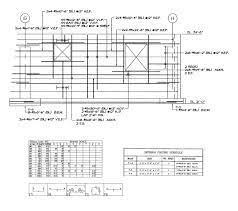Shop drawings serve as essential blueprints in the construction industry, offering detailed representations of architectural and engineering plans. These technical documents provide invaluable guidance to contractors, fabricators, and installers, elucidating the intricate details of a project’s design.
From the structural elements of mechanical systems, shop drawing delineate dimensions, materials, and assembly methods with precision. By bridging the gap between design intent and on-site implementation, shop drawings facilitate seamless communication and collaboration among project stakeholders.
In essence, they are the backbone of construction projects, ensuring accuracy, efficiency, and adherence to specifications.
Deciphering Shop Drawings: Blueprint of Construction Precision
Shop drawings are detailed illustrations or diagrams created by contractors, manufacturers, or fabricators to elucidate the design and installation specifics of a construction project.
These drawings provide precise measurements, materials, and assembly instructions for various elements, including structural components, mechanical systems, and architectural details.
Serving as a crucial communication tool between designers, engineers, and builders, shop drawings ensure that the envisioned design is accurately realized on-site. They play a pivotal role in streamlining construction processes, enhancing coordination, and minimizing errors during fabrication and installation.
In essence, shop drawings are the blueprint of construction precision, guiding the meticulous execution of every aspect of a building project.
There are several types of shop drawing used in construction projects, each serving a specific purpose and providing detailed information for different aspects of the building process. Some common types include:
- Architectural Shop Drawings: These drawings depict architectural elements such as floor plans, elevations, sections, and details. They provide information on finishes, materials, and dimensions for items like doors, windows, partitions, and exterior cladding.
- Structural Shop Drawings: Structural drawings detail the layout, dimensions, and specifications of structural components such as beams, columns, foundations, and connections. They include information on material properties, reinforcement details, and load-bearing capacities.
- Mechanical Shop Drawings: Mechanical drawings focus on HVAC (Heating, Ventilation, and Air Conditioning) systems, plumbing, and fire protection. They illustrate the layout, sizing, and routing of ductwork, piping, equipment, and fixtures, as well as control systems and connections.
- Electrical Shop Drawings: Electrical drawings outline the placement, sizing, and specifications of electrical components, including lighting fixtures, outlets, switches, panels, and wiring. They also indicate circuitry, voltage requirements, and coordination with other building systems.
- Millwork Shop Drawings: These drawings detail custom millwork and cabinetry, providing dimensions, materials, finishes, and assembly instructions for items such as built-in shelves, cabinets, countertops, and architectural woodwork.
- Miscellaneous Shop Drawings: Depending on the project scope, there may be additional types of shop drawings for specialized components such as signage, metalwork, glasswork, or specialty equipment installations.
Overall, shop drawing play a crucial role in ensuring accurate fabrication, assembly, and installation of building components, facilitating coordination and communication among project stakeholders.
Navigating the Mechanics of Shop Drawings: Ensuring Construction Precision
Shop drawing are comprehensive documents that play a fundamental role in the construction process, providing detailed guidance for the fabrication, assembly, and installation of various components within a building project.
- Interpretation of Design Intent: Initially, shop drawers carefully analyze the architectural and engineering plans provided by the design team to understand the intended design and specifications.
- Detailed Documentation: Using specialized software and technical expertise, shop drawers meticulously translate the design concepts into detailed illustrations or diagrams. These drawings include precise measurements, materials, finishes, and assembly instructions for each component.
- Collaboration and Coordination: Shop drawers collaborate closely with architects, engineers, contractors, and subcontractors to ensure alignment with design intent and project requirements. They address any discrepancies or conflicts that may arise during the review process.
- Fabrication and Installation Guidance: Once approved, shop drawing serve as a roadmap for manufacturers, fabricators, and installers, guiding them in the production and placement of building elements. This includes structural steel, HVAC systems, millwork, and architectural details.
- Quality Assurance: Throughout the construction process, shop drawer may conduct site visits or inspections to verify that the fabricated components conform to the approved drawings and meet quality standards.
- Iterative Process: Shop drawing revisions may be necessary to accommodate changes or modifications during construction, ensuring that the final built environment reflects the intended design intent.
In essence, shop drawings facilitate efficient communication, coordination, and precision in construction projects, ensuring that the envisioned design is realized with accuracy and integrity.
Conclusion
In conclusion, the various types of shop drawing are indispensable tools in the construction industry, providing detailed guidance and specifications for the fabrication, assembly, and installation of building components. From architectural elements to structural, mechanical, and electrical systems, shop drawings play a vital role in ensuring precision and coordination throughout the construction process.
At McLine Studios, our commitment to excellence extends to the production of high-quality shop drawing that reflect the vision and requirements of each project. By leveraging our expertise in drafting and collaboration with architects, engineers, and contractors, we strive to deliver shop drawing that meet the highest standards of accuracy, clarity, and efficiency.
Through meticulous attention to detail and adherence to industry best practices, McLine Studios aims to streamline construction processes, minimize errors, and enhance project outcomes. Our dedication to excellence in shop drawing production underscores our commitment to delivering exceptional results and contributing to the success of every construction project we undertake.



